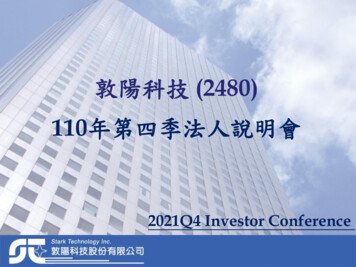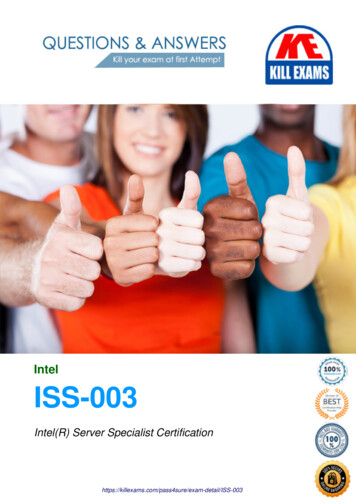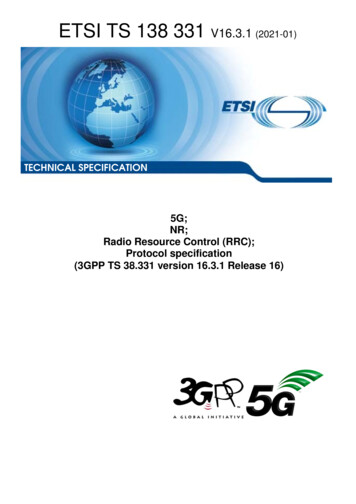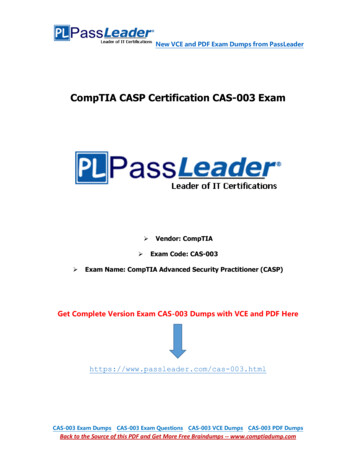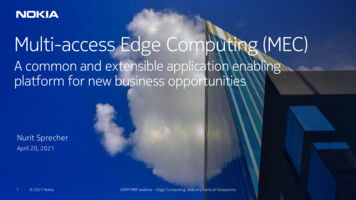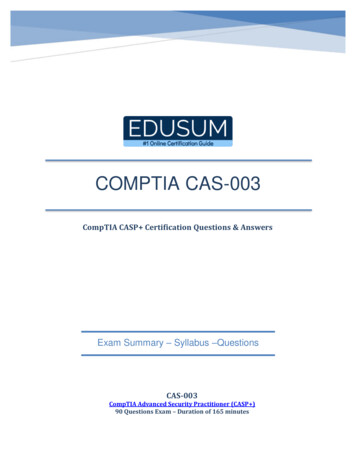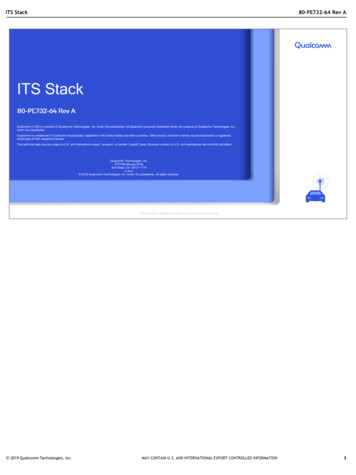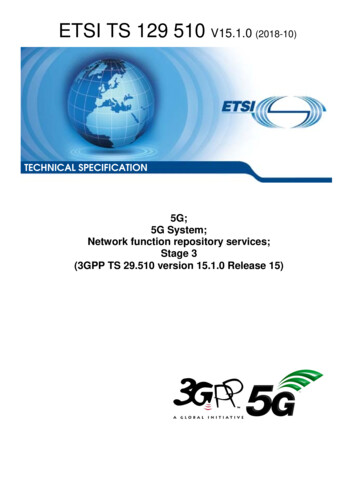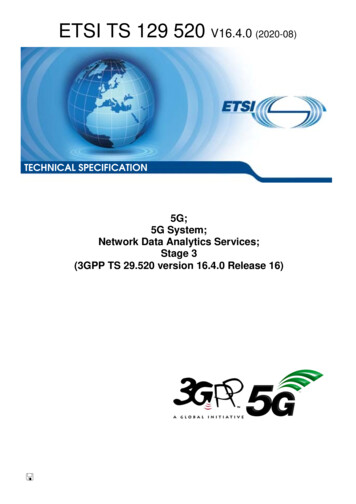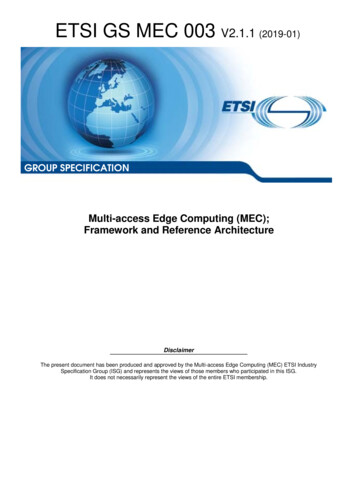
Transcription
ETSI GS MEC 003 V2.1.1 (2019-01)GROUP SPECIFICATIONMulti-access Edge Computing (MEC);Framework and Reference ArchitectureDisclaimerThe present document has been produced and approved by the Multi-access Edge Computing (MEC) ETSI IndustrySpecification Group (ISG) and represents the views of those members who participated in this ISG.It does not necessarily represent the views of the entire ETSI membership.
2ETSI GS MEC 003 V2.1.1 itecture, MECETSI650 Route des LuciolesF-06921 Sophia Antipolis Cedex - FRANCETel.: 33 4 92 94 42 00 Fax: 33 4 93 65 47 16Siret N 348 623 562 00017 - NAF 742 CAssociation à but non lucratif enregistrée à laSous-Préfecture de Grasse (06) N 7803/88Important noticeThe present document can be downloaded from:http://www.etsi.org/standards-searchThe present document may be made available in electronic versions and/or in print. The content of any electronic and/orprint versions of the present document shall not be modified without the prior written authorization of ETSI. In case of anyexisting or perceived difference in contents between such versions and/or in print, the prevailing version of an ETSIdeliverable is the one made publicly available in PDF format at www.etsi.org/deliver.Users of the present document should be aware that the document may be subject to revision or change of status.Information on the current status of this and other ETSI documents is available .aspxIf you find errors in the present document, please send your comment to one of the following pportStaff.aspxCopyright NotificationNo part may be reproduced or utilized in any form or by any means, electronic or mechanical, including photocopyingand microfilm except as authorized by written permission of ETSI.The content of the PDF version shall not be modified without the written authorization of ETSI.The copyright and the foregoing restriction extend to reproduction in all media. ETSI 2019.All rights reserved.DECTTM, PLUGTESTSTM, UMTSTM and the ETSI logo are trademarks of ETSI registered for the benefit of its Members.3GPPTM and LTETM are trademarks of ETSI registered for the benefit of its Members andof the 3GPP Organizational Partners.oneM2M logo is a trademark of ETSI registered for the benefit of its Members andof the oneM2M Partners.GSM and the GSM logo are trademarks registered and owned by the GSM Association.ETSI
3ETSI GS MEC 003 V2.1.1 (2019-01)ContentsIntellectual Property Rights .5Foreword.5Modal verbs terminology.51Scope .62References .62.12.233.13.23.3Normative references . 6Informative references . 6Definition of terms, symbols and abbreviations .7Terms. 7Symbols . 7Abbreviations . 74Overview .75Multi-access Edge Computing framework .86Reference architecture .27.2.37.2.488.18.28.38.4Generic reference architecture . 9Reference architecture variant for MEC in NFV . 10Description. 10Architecture diagram . 10Functional elements and reference points .11Functional elements . 11MEC host . 11MEC platform . 11MEC application . 12MEC system level management. 12Multi-access edge orchestrator . 12Operations Support System (OSS) . 12User application lifecycle management proxy . 12MEC host level management . 13MEC platform manager. 13Virtualization infrastructure manager . 13Device application . 13Customer facing service portal . 13Specific functional elements in the MEC in NFV architecture variant . 14Overview . 14MEC application orchestrator . 14MEC platform manager – NFV . 14NFVO . 14VNFM (MEC Platform LCM) . 14VNFM (MEC App LCM) . 14Reference points . 14Reference points related to the MEC platform . 14Reference points related to the MEC management . 15Reference points related to external entities . 15Reference points related to the MEC in NFV architecture variant . 15MEC services .16General . 16Radio Network Information . 16Location. 17Bandwidth Manager . 17Annex A (informative):Key concepts .18ETSI
4ETSI GS MEC 003 V2.1.1 (2019-01)A.1MEC host selection .18A.2DNS support .18A.3Application traffic filtering and routing .19A.4Support of application and UE mobility.19A.4.1Background: UE mobility . 19A.4.2MEC application scenarios for UE mobility . 19A.4.2.1MEC applications not sensitive to UE mobility. 19A.4.2.2MEC applications sensitive to UE mobility . 19A.4.2.2.1Maintaining connectivity between UE and MEC application instance . 19A.4.2.2.2Application state relocation. 19A.4.2.2.3Application instance relocation within the MEC system . 20A.4.2.2.4Application instance relocation between the MEC system and an external cloud environment . 20A.5Void .20A.6Data Plane .20A.7Inter-MEC system communication .20History .21ETSI
5ETSI GS MEC 003 V2.1.1 (2019-01)Intellectual Property RightsEssential patentsIPRs essential or potentially essential to normative deliverables may have been declared to ETSI. The informationpertaining to these essential IPRs, if any, is publicly available for ETSI members and non-members, and can be foundin ETSI SR 000 314: "Intellectual Property Rights (IPRs); Essential, or potentially Essential, IPRs notified to ETSI inrespect of ETSI standards", which is available from the ETSI Secretariat. Latest updates are available on the ETSI Webserver (https://ipr.etsi.org/).Pursuant to the ETSI IPR Policy, no investigation, including IPR searches, has been carried out by ETSI. No guaranteecan be given as to the existence of other IPRs not referenced in ETSI SR 000 314 (or the updates on the ETSI Webserver) which are, or may be, or may become, essential to the present document.TrademarksThe present document may include trademarks and/or tradenames which are asserted and/or registered by their owners.ETSI claims no ownership of these except for any which are indicated as being the property of ETSI, and conveys noright to use or reproduce any trademark and/or tradename. Mention of those trademarks in the present document doesnot constitute an endorsement by ETSI of products, services or organizations associated with those trademarks.ForewordThis Group Specification (GS) has been produced by ETSI Industry Specification Group (ISG) Multi-access EdgeComputing (MEC).Modal verbs terminologyIn the present document "shall", "shall not", "should", "should not", "may", "need not", "will", "will not", "can" and"cannot" are to be interpreted as described in clause 3.2 of the ETSI Drafting Rules (Verbal forms for the expression ofprovisions)."must" and "must not" are NOT allowed in ETSI deliverables except when used in direct citation.ETSI
61ETSI GS MEC 003 V2.1.1 (2019-01)ScopeThe present document provides a framework and reference architecture for Multi-access Edge Computing that describesa MEC system that enables MEC applications to run efficiently and seamlessly in a multi-access network. The presentdocument also describes the functional elements and the reference points between them, and a number of MEC servicesthat comprise the solution. It finally presents a number of key concepts related to the multi-access edge architecture.2References2.1Normative referencesReferences are either specific (identified by date of publication and/or edition number or version number) ornon-specific. For specific references, only the cited version applies. For non-specific references, the latest version of thereferenced document (including any amendments) applies.Referenced documents which are not found to be publicly available in the expected location might be found athttps://docbox.etsi.org/Reference/.NOTE:While any hyperlinks included in this clause were valid at the time of publication, ETSI cannot guaranteetheir long term validity.The following referenced documents are necessary for the application of the present document.[1]ETSI GS MEC 002: "Multi-access Edge Computing (MEC); Use Cases and Requirements".[2]ETSI GS NFV 002: "Network Functions Virtualisation (NFV); Architectural Framework".[3]ETSI GS NFV-IFA 013: "Network Functions Virtualisation (NFV); Management andOrchestration; Os-Ma-Nfvo reference point - Interface and Information Model Specification".[4]ETSI GS NFV-IFA 008: "Network Functions Virtualisation (NFV); Management andOrchestration; Ve-Vnfm reference point - Interface and Information Model Specification".2.2Informative referencesReferences are either specific (identified by date of publication and/or edition number or version number) ornon-specific. For specific references, only the cited version applies. For non-specific references, the latest version of thereferenced document (including any amendments) applies.NOTE:While any hyperlinks included in this clause were valid at the time of publication, ETSI cannot guaranteetheir long term validity.The following referenced documents are not necessary for the application of the present document but they assist theuser with regard to a particular subject area.[i.1]ETSI GS MEC 001: "Multi-access Edge Computing (MEC); Terminology".[i.2]Void.[i.3]"OpenStack for Cloudlet Deployment".NOTE:Available at U-CS-15-123.pdf.[i.4]Void.[i.5]ETSI GR MEC 017: "Mobile Edge Computing (MEC); Deployment of Mobile Edge Computing inan NFV environment".[i.6]ETSI TS 123 501: "System Architecture for the 5G System, Stage 2 (Release 15)".ETSI
7ETSI GS MEC 003 V2.1.1 (2019-01)3Definition of terms, symbols and abbreviations3.1TermsFor the purposes of the present document, the terms given in ETSI GS MEC 001 [i.1] apply.3.2SymbolsVoid.3.3AbbreviationsFor the purposes of the present document, the abbreviations given in ETSI GS MEC 001 [i.1] and the following ustomer Facing ServiceLifeCycle ManagementMEC Application OrchestratorMEC Platform Manager - NFVNetwork Functions VirtualizationNFV OrchestratorNetwork Functions Virtualization InfrastructureNetwork ServiceOperations Support SystemVirtualization Infrastructure ManagerVirtualized Network FunctionVNF ManagerOverviewThe present document presents a framework and a reference architecture to support the requirements defined forMulti-access Edge Computing in ETSI GS MEC 002 [1].The framework described in clause 5 shows the structure of the Multi-access Edge Computing environment.The reference architecture described in clause 6 shows the functional elements that compose the multi-access edgesystem, including the MEC platform and the MEC management, as well as the reference points between them.The functional elements and reference points listed in clause 7 describe the high-level functionality of the differentfunctional elements and reference points.Clause 8 describes the high-level functionality of a number of MEC services, comprising the solution for Multi-accessEdge Computing.Annex A describes at a high-level a number of key concepts that underlie the principles used to develop the frameworkand reference architecture described in the present document.ETSI
85ETSI GS MEC 003 V2.1.1 (2019-01)Multi-access Edge Computing frameworkMulti-access Edge Computing enables the implementation of MEC applications as software-only entities that run on topof a virtualization infrastructure, which is located in or close to the network edge. The Multi-access Edge Computingframework shows the general entities involved. These can be grouped into system level, host level and network levelentities.Figure 5-1: Multi-access Edge Computing frameworkFigure 5-1 illustrates the framework for Multi-access Edge Computing consisting of the following entities: MEC host, including the following:-MEC platform;-MEC applications;-virtualization infrastructure; MEC system level management; MEC host level management; external related entities, i.e. network level entities.ETSI
96Reference architecture6.1Generic reference architectureETSI GS MEC 003 V2.1.1 (2019-01)The reference architecture shows the functional elements that comprise the multi-access edge system and the referencepoints between them.Figure 6-1 depicts the generic multi-access edge system reference architecture. There are three groups of referencepoints defined between the system entities: reference points regarding the MEC platform functionality (Mp); management reference points (Mm); and reference points connecting to external entities (Mx).Figure 6-1: Multi-access edge system reference architectureThe multi-access edge system consists of the MEC hosts and the MEC management necessary to run MEC applicationswithin an operator network or a subset of an operator network.The MEC host is an entity that contains a MEC platform and a virtualization infrastructure which provides compute,storage, and network resources, for the purpose of running MEC applications. The MEC host is further described inclause 7.1.1.The MEC platform is the collection of essential functionality required to run MEC applications on a particularvirtualization infrastructure and enable them to provide and consume MEC services. The MEC platform can alsoprovide services. The MEC platform is further described in clause 7.1.2.MEC applications are instantiated on the virtualization infrastructure of the MEC host based on configuration orrequests validated by the MEC management. MEC applications are further described in clause 7.1.3.ETSI
10ETSI GS MEC 003 V2.1.1 (2019-01)The MEC management comprises the MEC system level management and the MEC host level management.The MEC system level management includes the Multi-access edge orchestrator as its core component, which has anoverview of the complete MEC system. The MEC system level management is further described in clause 7.1.4.The MEC host level management comprises the MEC platform manager and the virtualization infrastructuremanager, and handles the management of the MEC specific functionality of a particular MEC host and the applicationsrunning on it. The MEC host level management is further described in clause 7.1.5.6.2Reference architecture variant for MEC in NFV6.2.1DescriptionMulti-access Edge Computing (MEC) and Network Functions Virtualization (NFV) are complementary concepts. TheMEC architecture has been designed in such a way that a number of different deployment options of MEC systems arepossible. A dedicated Group Report, ETSI GR MEC 017 [i.5], provides an analysis of solution details of thedeployment of MEC in an NFV environment.In clauses 6.2.2, 7.1.8 and 7.2.4 of the present document, a MEC architecture variant is specified that allows toinstantiate MEC applications and NFV virtualized network functions on the same virtualization infrastructure, and to reuse ETSI NFV MANO components to fulfil a part of the MEC management and orchestration tasks.6.2.2Architecture diagramFigure 6-2 depicts a variant of the multi-access edge system reference architecture for the deployment in a NetworkFunctions Virtualization (NFV) environment [2].In addition to the definitions for the generic reference architecture in clause 6.1, the following new architecturalassumptions apply: The MEC platform is deployed as a VNF. The MEC applications appear as VNFs towards the ETSI NFV MANO components. The virtualization infrastructure is deployed as an NFVI and is managed by a VIM as defined by ETSIGS NFV 002 [2]. The MEC platform manager (MEPM) is replaced by a MEC platform manager - NFV (MEPM-V) thatdelegates the VNF lifecycle management to one or more VNF managers (VNFM). The MEC orchestrator (MEO) is replaced by a MEC application orchestrator (MEAO) that relies on the NFVorchestrator (NFVO) for resource orchestration and for orchestration of the set of MEC application VNFs asone or more NFV network services (NSs).The new reference points shown in figure 6-2 are further described in clause 7.2.4.ETSI
11ETSI GS MEC 003 V2.1.1 (2019-01)Figure 6-2: Multi-access edge system reference architecture variant for MEC in NFV7Functional elements and reference points7.1Functional elements7.1.1MEC hostThe MEC host is an entity that contains the MEC platform and a virtualization infrastructure which provides compute,storage, and network resources for the MEC applications. The virtualization infrastructure includes a data plane thatexecutes the traffic rules received by the MEC platform, and routes the traffic among applications, services, DNSserver/proxy, 3GPP network, other access networks, local networks and external networks.7.1.2MEC platformThe MEC platform is responsible for the following functions: offering an environment where the MEC applications can discover, advertise, consume and offer MECservices (see clause 8), including, when supported, MEC services available via other platforms (that may be inthe same or a different MEC system);ETSI
12ETSI GS MEC 003 V2.1.1 (2019-01) receiving traffic rules from the MEC platform manager, applications, or services, and instructing the data planeaccordingly. When supported, this includes the translation of tokens representing UEs in the traffic rules intospecific IP addresses; receiving DNS records from the MEC platform manager and configuring a DNS proxy/server accordingly; hosting MEC services, possibly including services that are described in clause 8; providing access to persistent storage and time of day information.7.1.3MEC applicationMEC applications are running as virtual machines (VM) on top of the virtualization infrastructure provided by the MEChost, and can interact with the MEC platform to consume and provide MEC services (described in clause 8).In certain cases, MEC applications can also interact with the MEC platform to perform certain support proceduresrelated to the lifecycle of the application, such as indicating availability, preparing relocation of user state, etc.MEC applications can have a certain number of rules and requirements associated to them, such as required resources,maximum latency, required or useful services, etc. These requirements are validated by the MEC system levelmanagement, and can be assigned to default values if missing.7.1.4MEC system level management7.1.4.1Multi-access edge orchestratorThe multi-access edge orchestrator is the core functionality in MEC system level management.The multi-access edge orchestrator is responsible for the following functions: maintaining an overall view of the MEC system based on deployed MEC hosts, available resources, availableMEC services, and topology; on-boarding of application packages, including checking the integrity and authenticity of the packages,validating application rules and requirements and if necessary adjusting them to comply with operator policies,keeping a record of on-boarded packages, and preparing the virtualization infrastructure manager(s) to handlethe applications; selecting appropriate MEC host(s) for application instantiation based on constraints, such as latency, availableresources, and available services; triggering application instantiation and termination; triggering application relocation as needed when supported.7.1.4.2Operations Support System (OSS)The Operations Support System (OSS) in figure 6-1 refers to the OSS of an operator. It receives requests via the CFSportal and from device applications for instantiation or termination of applications, and decides on the granting of theserequests. Granted requests are forwarded to the multi-access edge orchestrator for further processing.When supported, the OSS also receives requests from device applications for relocating applications between externalclouds and the MEC system.7.1.4.3User application lifecycle management proxyA user application is a MEC application that is instantiated in the MEC system in response to a request of a user via anapplication running in the device (device application).The user application lifecycle management proxy allows device applications to request on-boarding, instantiation,termination of user applications and when supported, relocation of user applications in and out of the MEC system. Italso allows informing the device applications about the state of the user applications.ETSI
13ETSI GS MEC 003 V2.1.1 (2019-01)The user application lifecycle management proxy authorizes requests from device applications in the device (e.g. UE,laptop with internet connectivity) and interacts with the OSS and the multi-access edge orchestrator for furtherprocessing of these requests.The user application lifecycle management proxy is only available when supported by the MEC system.7.1.57.1.5.1MEC host level managementMEC platform managerThe MEC platform manager is responsible for the following functions: managing the life cycle of applications including informing the multi-access edge orchestrator of relevantapplication related events; providing element management functions to the MEC platform; managing the application rules and requirements including service authorizations, traffic rules, DNSconfiguration and resolving conflicts.The MEC platform manager also receives virtualized resources fault reports and performance measurements from thevirtualization infrastructure manager for further processing.7.1.5.2Virtualization infrastructure managerThe virtualization infrastructure manager is responsible for the following functions: allocating, managing and releasing virtualized (compute, storage and networking) resources of thevirtualization infrastructure; preparing the virtualization infrastructure to run a software image. The preparation includes configuring theinfrastructure, and can include receiving and storing the software image; when supported, rapid provisioning of applications, as described in "Openstack for Cloudlet Deployments"[i.3]; collecting and reporting performance and fault information about the virtualized resources; when supported, performing application relocation. For application relocation from/to external cloudenvironments, the virtualization infrastructure manager interacts with the external cloud manager to performthe application relocation, for example using the mechanism described in "Adaptive VM Handoff AcrossCloudlets" [i.3], possibly through a proxy.The fun
[2] ETSI GS NFV 002: "Network Functions Virtualisation (NFV); Architectural Framework". [3] ETSI GS NFV-IFA 013: "Network Functions Virtualisation (NFV); Management and Orchestration; Os-Ma-Nfvo reference point - Interface and Information Model Specification".
